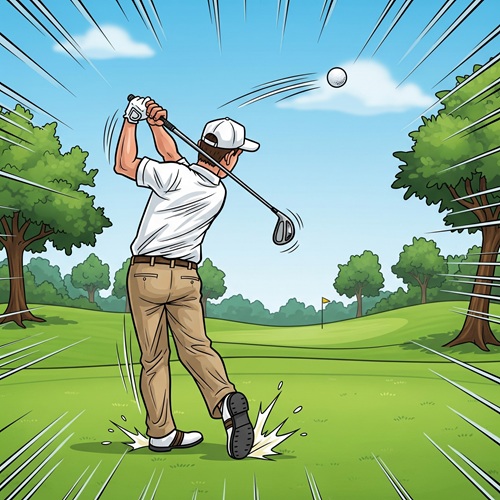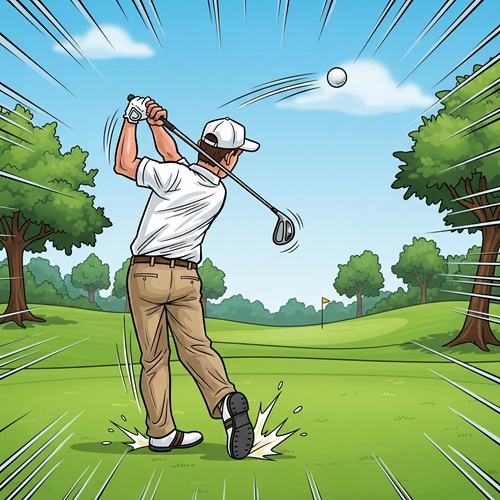Types of Golf Swings
Golf swing technique has evolved dramatically over the decades, with players and instructors developing various swing methods to maximize performance and consistency.
While the fundamentals remain constant, like maintaining balance, generating power, and achieving accuracy in the swing, the path to these goals varies significantly between different golf swing types.

Each swing type offers unique advantages and challenges, making the choice deeply personal to every golfer’s journey toward improvement.
In this article, we’ll take a deep dive into understanding the various types of golf swings available, which can help you identify which swing style best suits your physical attributes, skill level, and playing style.
5 Types of Golf Swings
The modern golf game features several distinct swing methods, each with devoted followers and proven results at the highest levels.
These five primary types of golf swing styles help most golfers produce different approaches to generating power, maintaining consistency, and achieving optimal ball flight.
1. Traditional Swing
The traditional swing represents the classic method taught by instructors for generations and remains the foundation of most golf instruction today.
This swing method emphasizes a full body rotation away from the target, body weight transfer from the back foot to the lead foot, and a natural release of the club head through impact.
The traditional swing methods focus on creating a wide arc with proper sequencing of body movements, starting from the ground up with leg drive, hip rotation, and shoulder turn working together as one.
The traditional swing offers significant advantages as a time-tested method with proven results across all skill levels.
Its greatest strength lies in generating maximum power through full body rotation and weight transfer, while maintaining a natural feel that most golfers can learn and replicate.
However, the traditional swing presents notable challenges, particularly its requirement for significant flexibility and coordination, which are critical elements in creating success.
Elderly golfers or those with physical limitations often struggle with the demanding body rotation and timing requirements of this swing style.
Professional golfers who used the traditional swing to great success include Tiger Woods, whose classic technique has dominated golf for decades, showcasing the power and precision possible with proper traditional swing methods.
Rory McIlroy represents a great example of the athletic, dynamic version of the traditional swing that dominates professional golf today with his explosive body rotation and powerful weight transfer that revolutionized his on course performance and helped him win this year’s Masters.
2. Stack and Tilt Swing
The stack and tilt swing method revolutionized golf instruction by challenging conventional wisdom about swing path, weight transfer, and spine angle.
Developed by instructors Andy Plummer and Mike Bennett, this tilt swing technique keeps the golfer’s body weight favoring the front foot throughout the entire swing while maintaining a forward spine tilt.
The stack and tilt method emphasizes hitting down on the golf ball with a descending blow, creating consistent ball striking and eliminating the complexity of traditional weight shift.
The primary advantage of the stack and tilt swing is its ability to promote consistent ball striking by reducing the complexity of weight transfer.
The main drawback of the stack and tilt method is its potential to limit maximum distance compared to traditional swing methods.
Many golfers find the tilt golf swing feels unnatural initially, especially those taught with conventional methods, and it proves less effective for driver and longer clubs, where distance generation becomes critical.
Professional golfers who have adopted the stack and tilt swing principles include Aaron Baddeley, who worked extensively with the method’s creators and saw improved consistency in his iron play on the PGA Tour.
3. Single Plane Swing
The single plane swing involves swinging the golf club on the same plane throughout the entire motion.
This one-plane swing method positions the golfer’s arms and club shaft on the same plane at address and maintains that relationship throughout the entire swing.
The single plane swing’s greatest strength is its extreme consistency and repeatability, eliminating timing issues between different rotational swing planes.
This momentum swing method creates a more geometric motion that’s easier to maintain under pressure, making it excellent for accuracy and consistent ball flight trajectory while building better muscle memory through simplified mechanics.
The primary limitation of this separation-based swing method is that it may sacrifice some distance compared to traditional swing methods.
Additionally, the technique requires specific setup positions, including maintaining a consistent spine angle.
Bryson DeChambeau has become the most famous advocate of single plane swing principles, incorporating the method’s emphasis on consistency and repeatability into his scientific approach to golf.
DeChambeau’s success with one plane concepts demonstrates how the method can work at the highest level when combined with modern technology and constant data analysis.
4. Hands and Arms Swing
The hands and arms swing emphasize upper body control while minimizing lower body movement and hip rotation.
This technique relies primarily on arm swing and hand action to generate clubhead speed, with the body providing stability rather than power.
The arms swing method appeals to golfers who struggle with timing the complex body movements of traditional swing methods or those seeking greater control and precision in their golf shots.
The hands and arms swing excels in providing accuracy and control while being easier to time and repeat consistently than full-body swing methods.
This controlled swing approach is less physically demanding than traditional swing techniques, making it particularly effective for precision play and reducing variables that can cause inconsistency in golf shots.
The main disadvantage of the arms swing method is its limited generating power capability compared to full-body techniques.
Golfers using this swing style may struggle with longer clubs and the distance requirements of modern golf course layouts, and the method can sometimes lead to overactive hands that result in inconsistent clubface control throughout the entire swing.
PGA Tour golfers who rely heavily on hands and arms swing techniques include Jason Day, who emphasizes quiet lower body movement and precise hand action for his consistent ball striking.
Zach Johnson has also built his career around a controlled, hands-and-arms-dominant swing style that prioritizes accuracy over distance.
5. Hold Off Swing
The hold off swing involves deliberately restricting the release of the club head through impact, maintaining a firmer left wrist (for right handed golfers) and less forearm rotation.
This technique is often employed in windy conditions or when golfers need to control ball flight and reduce spin.
The hold off method creates a more penetrating ball flight with less curve, making it valuable for specific course conditions and strategic situations on the golf course.
This swing method excels in windy conditions and firm courses, where its ability to reduce hooks and draws creates lower, straighter ball flight.
This technique produces a lower, more controlled swing, penetrating trajectory that provides better distance control in adverse conditions, making it invaluable for strategic course management when control ball flight becomes essential.
The primary drawback of the hold off technique is that it can lead to blocks and pushes when overdone, particularly for right handed golfers who may struggle with timing.
Pros typically use the hold off swing method during windy tournaments, particularly in coastal venues where controlling the ball’s trajectory becomes crucial.
Links golf in Scotland and Ireland often demands hold off techniques to keep the golf ball under the wind and achieve optimal distance.
Tournament conditions, such as firm and fast greens, also favor the hold-off method’s penetrating ball flight and reduced spin characteristics due to its roll out.
Why the Traditional Swing Method Remains Popular
The traditional swing method remains popular because it represents the most natural and athletic way to generate power while maintaining accuracy.
This time-tested approach enables golfers to utilize their entire body effectively, generating maximum swing speed through proper sequencing and timing.
The traditional swing’s versatility makes it effective for all clubs and shot situations, from delicate chip shot techniques to powerful ball flight drives.
Most importantly, the abundance of instruction and resources available for traditional swing methods means golfers can easily find qualified teachers and learning materials, making improvement more accessible and systematic for most golfers seeking a good golf swing.
Benefits of Alternate Swing Styles
Alternative swing styles offer unique solutions to common golf challenges and can unlock potential that traditional swing methods might not address for certain golfers.
DeChambeau exemplifies how alternative approaches can revolutionize performance, using single plane swing principles and scientific analysis to achieve unprecedented consistency and distance with his consistent swing.
His approach shows how alternative swing styles can provide competitive advantages when properly implemented and practiced with dedication on the driving range and beyond.
These different types of golf techniques allow golfers to find methods that match their physical capabilities, learning style, and performance goals, proving that there is no single path to golf excellence.
Frequently Asked Questions
What are the different types of golf swings?
Golf swings vary by technique and philosophy. The Traditional Golf Swing emphasizes weight shift and rotation, while Stack and Tilt keeps weight forward throughout.
A swing like the Hands and Arms swing minimizes body rotation, focusing on arm action. In contrast, the Hold Off swing restricts release for controlled shot flight.
Finally, the One Plane swing maintains a consistent swing plane for simplicity and repeatability.
What are the five golf swings?
The five main golf swing methods are:
- Traditional Golf Swing (classic weight transfer and rotation)
- Stack and Tilt (forward weight bias)
- Hands and Arms (minimal body turn)
- Hold Off Swing (restricted release through impact)
- One Plane Swing (single swing plane)
Each offers different approaches to achieving consistent ball striking and shot control.
What are bad golf swings called?
Poor golf swings have various names depending on the specific flaw. Common terms include:
- Over-the-top (steep downswing)
- Casting (early release)
- Chicken wing (bent lead arm)
- Reverse pivot” (weight shift error)
- Sway (lateral movement)
- Coming up (lifting during impact)
These swing flaws create inconsistent ball striking and poor shot results.
What are the names of bad golf shots?
Bad golf shots have colorful names like:
- Slice (ball curves right)
- Hook (curves left)
- Shank (off the hosel)
- Top (hitting the ball’s top)
- Chunk/fat (hitting ground first)
- Thin/skull (hitting ball’s equator)
- Whiff (complete miss)
- Duck hook (severe left curve)
- Banana ball (extreme slice)
Each describes specific ball flight patterns and demands specific golf swing tips to correct.
